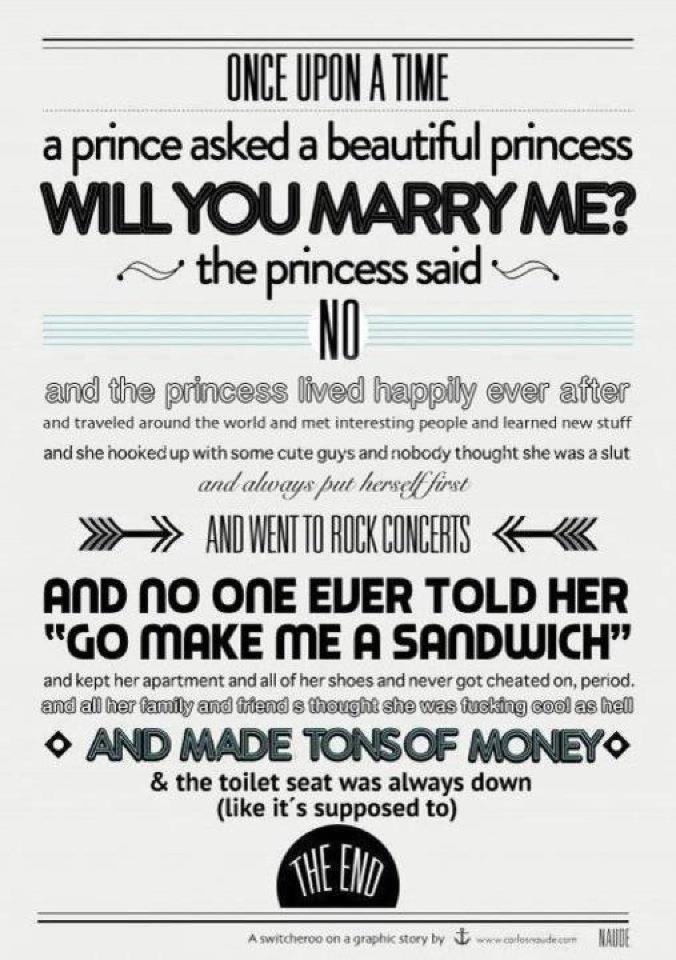The first time I saw this internet image was three or four years ago. Over the years it has been sent to me many times. I suppose people know I would enjoy it and maybe this is my future fairy tale.
A fairy tale is described as being idyllic, extremely happy, and what essentially someone dreams and hopes for. It is the quintessential happily ever after. Disney folklore has been under siege in recent years for exemplifying unhealthy gender roles and stereotypes for the young women it is aimed towards. The Disney princess empire is estimated to be worth approximately $4 billion dollars. It elevates the ultimate aspiration in life to being with Prince Charming, and the ultimate duty to be the perfect home-maker.

Taking a critical look at the classic princesses, misogynistic actions are actively reinforced in these fairy tales, beyond the damsel in distress, perfect homemaker archetype. Aurora marries a man who molests her in her sleep. Ariel endures lifestyle altering plastic surgery to be with a man. Belle remains with an abusive man hoping he will change. How can a little girl who grew up idealizing these tales, identify these episodes as sexual violence as an adult? Why are boys being taught this is an acceptable way to get the girl?
I grew up with these fairy tales. I do not feel any life-altering psychological damage as a result. Unfortunately I think that is only because the ideals are so inherent and reinforced with every social construct no one particular thing can be attributed as the cause of why society is still clutching to these gender identities.
I have nieces and cousins who are on the cusp of beginning to play with dolls and watch cartoons and I wonder if giving them an alternative type of fairy tale of girls who fight oppression, seek higher education, and do not need or require a man would make a difference. With a quick internet search I found some interesting results. An example of which is:
A story of a princess who rescues the prince from dragons, and still chooses not to be with him (all while wearing a paper bag).
With children watching an average of 2-3 hours of television a day, it might not hurt to see some evolution in the typical pop media geared towards little girls. It would not hurt for happily ever after to mean something besides Prince Charming.



5 comments:
As a young girl my Mom did not really let us watch disney movies. That doesnt mean i did not love Beauty and the Beast, it just means I only watched it my friend's house. Looking back now I agree with my Mother.
I do think that movies are changing. Recently I took my cousins to go see Brave. I loved the movie. It was such a great story about mother daughter relationships and included no love interest. It was the first Disney Princess who did not have a prince. I think this is a much better standard for little girls to look up to.
In some respects, I think Disney has paved the way in showing strong female characters who transcend traditional norms and stereotypes. For example, Mulan was willing to risk everything to fight for her country, something women were not allowed to do. Belle loved to read and she did not care that the rest of the town thought she was odd, and Pochahontus was the peacemaker between two waring cultures.
But you are right in that the stories are overwhelmingly obsessed with the idea that women NEED to find love. The idea of finding a "prince charming" is so engrained, that even twenty years later, I find myself using that phrase. While many people criticize Disney for creating unrealistic expectations about love and relationships, you have a great point in that those expectations are silly to begin with! The notion that women are damsels in distress is outdated, and I think Disney is finally starting to catch on.
The theme of this post reminds of other posts on Feminist Legal Theory that discuss women in the media and popular culture, yet I think the take on the Disney movies is an interesting twist. While I loved the Disney movies as a child, at that time I was blissfully unaware of the negative messages Pali discussed in this post. That is not to say the messages did not sink their teeth in subconsciously. Can we or should we keep children away from the Disney classics? Are there other moral lessons in the movies that make them worth keeping? Maybe it is nostalgia, but I would find it difficult to keep the Disney movies I enjoyed away from my future children. As long as the movies are complimented with other stories like the Paper Bag Princess, parents can use the Disney movies as a jumping off point to discuss negative portrayals of women.
The author's take on misogynistic actions in these fairy tales is extremely eye opening and something I've never really thought of. Also, I've been noticing more commentary surrounding the Disney debate as of late, especially regarding the unrealistic portrayal of classic disney characters. One of my biggest concerns with disney princesses is how unrealistic they are. Disney princesses are seemingly "perfect" physically - small waists, perfect hair, and beautiful. These princesses often become idols for young girls which is scary to me. The looks of these disney princesses are not only unhealthy but actually unobtainable. I have enjoyed reading articles that put reality into these characters - some explore if princesses had normal waistlines and realistic hair (See: http://www.boredpanda.com/realistic-disney-princess-waistlines-loryn-brantz/; http://www.buzzfeed.com/lorynbrantz/if-disney-princesses-had-realistic-hair#.uhm4aAKzr)! If these princesses are going to become who future generations of young girls look up to, then they need to be more realistic and ensure that healthy images are being portrayed!
Post a Comment